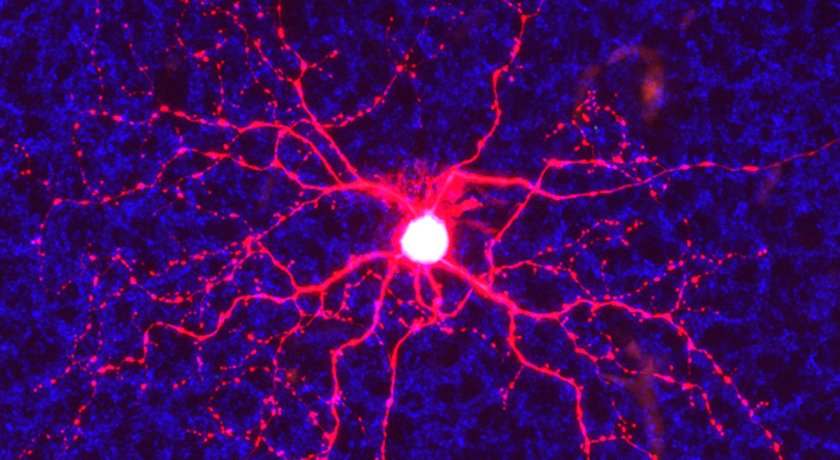For neurons, birthday matters
In the eye, nerve cells born early try many things, while ones born late stay focused

Retinal ganglion cells like this one have to make connections to other areas of the brain during development. A new study shows that how they go about making those connections is associated with when they were born.
Rana El-Danaf
- More than 2 years ago
For most of us, where our birthday falls in the year doesn’t matter much in the grand scheme of things. A July baby doesn’t make more mistakes than a Christmas kid — at least, not because of their birthdays. But for neurons, birth date plays an important role in how these cells find their connections in the brain, a new study finds. Nerve cells that form early in development will make lots of connections — and lots of mistakes. Neurons formed later are much more precise in their targeting.
The findings are an important clue to help scientists understand how the brain wires itself during development. And with more information on how the brain forms its network, scientists might begin to see what happens when that network is injured or malformed.
Many, many brain cells are born as the brain develops. Each one has to reach out and make connections, sometimes to other cells around them and sometimes to other regions of the brain. To do this, these nerve cells send out axons, long, incredibly thin projections that reach out to other regions. How mammalian axons end up at their final destination in the growing brain remains a mystery.
To find out how developing brains get wired up, Jessica Osterhout and colleagues at the University of California, San Diego and colleagues started in the eye. They looked at retinal ganglion cells, neurons that connect the brain and the eye. “It’s easy to access,” explains Andrew Huberman, a neuroscientist at UC San Diego and an author on the paper. “Your retina is basically part of the central nervous system that got squeezed into your eye during development.”
Retinal ganglion cells all have the same function: To convey visual information from the eyes to the brain. But they are not all the same. These cells have around 20 different subtypes, each responsible for carrying slightly different information to a different part of the brain. One subtype might carry information about pupil dilation, while another might carry information on light contrast. Each of these subtypes has to form connections with a different area of the brain that processes visual information.
To figure out how the cells find their way from the eye to their final destination in the brain, Osterhout and her colleagues examined mice that had been bred to make green fluorescent protein, or GFP. They focused on four different types of mice, each of which made GFP in a single type of retinal ganglion cell.
Osterhout studied the mouse embryos as they developed, tracking them to see when GFP glowed green, indicating a retinal ganglion cell was born. She then followed that GFP signal as the mice developed and was able to watch the retinal ganglion cells form their connections to other parts of the brain.
She found that cells born early reach for many areas of the brain and make lots of connections. Unfortunately, many of these connections will be to wrong areas, parts of the brain where the ganglion cell doesn’t need to go. These early-born cells have to retract some of their connections, correcting their “mistakes.” In contrast, late-born neurons are much more accurate, focusing on a single target brain area and only making connections there, rather than reaching out to many different areas. The scientists published their findings July 31 in Cell Reports.
It is all a matter of timing. “Think of is as people trying to park their cars in a place they’ve never been,” Huberman explains. “The cars leave and travel in the same general direction, but where do they park? Early departing cars try a lot of different spaces before they find the right one. The later-arriving cars have fewer choices and slide in wherever they can.”
Michael Fox, a developmental neuroscientist at Virginia Tech Carilion Research Institute in Roanoke, Va., says the results hint that different mechanisms guide brain cell growth, depending on when the cells are born. “The paper shows that the timing of development is important for the mechanism that a cell uses to find a target,” he says. “The different types of ganglion are not only distinct from each other, they form connections in unique ways.”
Experiments like these are important to help scientists understand how the brain puts itself together. “What so amazing is that unlike a circuit in a computer, the brain is self-assembling,” Huberman says. “The very cells that make up the circuit are the ones that put the circuit together. They don’t get instructions from the outside.”
Fox also hopes that techniques like the ones used in this experiment will be used to learn more about the brain under President Obama’s BRAIN Initiative. “If we want to regenerate an injured system,” Fox explains, “we have to understand how all these axons form connections in the first place. We can use technology like these mouse lines to answer important questions about developmental patterns,” he says. Learning more about the fine connections in the brain could be crucial to understanding what the wiring looks like, both in sickness and in health.






